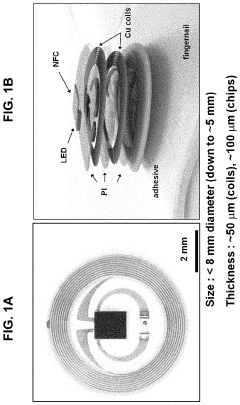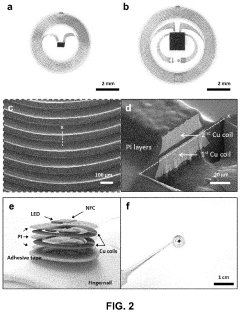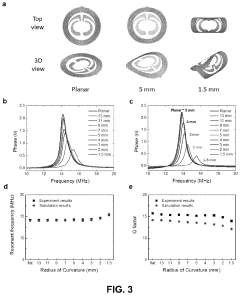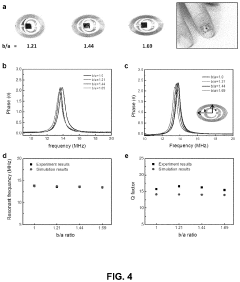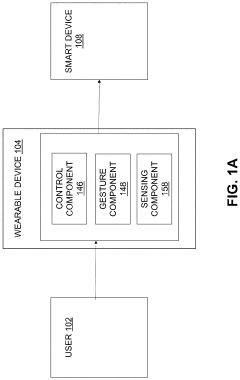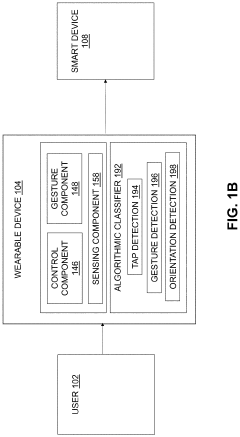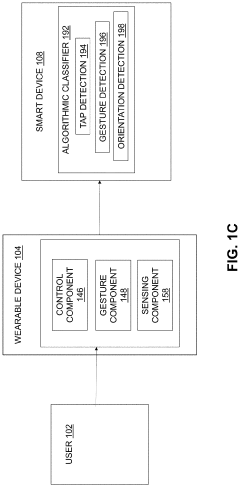Beyond Smartphones: Wearable and Implantable Tech in the Next Decade
MAY 12, 20259 MIN READ
Generate Your Research Report Instantly with AI Agent
Patsnap Eureka helps you evaluate technical feasibility & market potential.
Wearable Tech Evolution
Wearable technology has undergone a remarkable evolution since its inception, transforming from bulky, limited-function devices to sleek, multifunctional gadgets seamlessly integrated into our daily lives. The journey began with simple pedometers and basic fitness trackers, which laid the foundation for more sophisticated health monitoring devices. As miniaturization and battery technology improved, smartwatches emerged as a pivotal development, offering a compact form factor with increasingly advanced features. These devices initially focused on notifications and basic app functionality but quickly expanded to include comprehensive health tracking, contactless payments, and even cellular connectivity. The evolution continued with the introduction of smart glasses, which, despite initial setbacks, have found niche applications in enterprise and specialized consumer markets. Concurrently, hearables have gained significant traction, evolving from simple wireless earbuds to sophisticated in-ear computers capable of real-time translation, health monitoring, and augmented audio experiences. The progression of wearable technology has been marked by key milestones such as the integration of advanced sensors for more accurate health data collection, the development of flexible and stretchable electronics for improved comfort and durability, and the incorporation of AI and machine learning for personalized insights and predictive capabilities. Recent advancements have seen the emergence of smart fabrics and e-textiles, which promise to make wearable technology even more unobtrusive and integrated into everyday clothing. Looking ahead, the trajectory of wearable tech is moving towards even greater integration with the human body, with research into implantable and ingestible sensors pushing the boundaries of what's possible. The convergence of wearables with other emerging technologies like 5G, edge computing, and advanced materials science is set to unlock new possibilities, potentially revolutionizing fields such as healthcare, sports performance, and human-computer interaction. As we look to the next decade, the evolution of wearable technology is likely to focus on enhancing seamless integration, improving energy efficiency, and expanding the range of biometric data that can be accurately collected and analyzed, ultimately aiming to create a more symbiotic relationship between humans and technology.
Market Demand Analysis
The wearable and implantable technology market is poised for significant growth in the next decade, driven by increasing consumer demand for health monitoring, convenience, and enhanced connectivity. The global wearable technology market is expected to reach $265.4 billion by 2026, with a compound annual growth rate (CAGR) of 18.1% from 2021 to 2026. This growth is fueled by advancements in miniaturization, battery technology, and wireless connectivity, enabling the development of more sophisticated and user-friendly devices.
In the healthcare sector, wearable and implantable devices are gaining traction for continuous health monitoring, early disease detection, and personalized treatment. The market for medical wearables is projected to grow at a CAGR of 26.8% from 2021 to 2028, reaching $196.5 billion by 2028. This surge is driven by the increasing prevalence of chronic diseases, rising healthcare costs, and a growing emphasis on preventive healthcare.
The fitness and wellness segment continues to be a significant driver of wearable technology adoption. Smartwatches and fitness trackers remain popular, with an estimated 533 million devices expected to be in use globally by 2024. However, the market is evolving beyond wrist-worn devices to include smart clothing, hearables, and other form factors that seamlessly integrate into users' daily lives.
In the enterprise sector, wearable technology is finding applications in improving worker safety, enhancing productivity, and enabling hands-free operations. The industrial wearable market is expected to grow at a CAGR of 23.4% from 2020 to 2027, reaching $8.4 billion by 2027. Industries such as manufacturing, logistics, and healthcare are increasingly adopting wearable devices for tasks like remote assistance, inventory management, and patient care.
Implantable technology, while still in its early stages, shows promising growth potential. The global implantable medical devices market is projected to reach $153.8 billion by 2026, growing at a CAGR of 7.7% from 2021 to 2026. This growth is driven by advancements in biocompatible materials, miniaturization of electronics, and the development of novel implantable sensors and stimulators for various medical conditions.
Consumer acceptance and adoption of wearable and implantable technologies are expected to increase as devices become more sophisticated, less intrusive, and offer greater value in terms of health insights and lifestyle improvements. However, concerns about data privacy, security, and the long-term effects of implantable devices remain significant factors that could impact market growth.
As the technology evolves, we anticipate a shift towards more integrated and seamless user experiences, with wearables and implantables becoming an integral part of the Internet of Things (IoT) ecosystem. This integration will enable more comprehensive health monitoring, predictive analytics, and personalized interventions, further driving market demand across various sectors.
In the healthcare sector, wearable and implantable devices are gaining traction for continuous health monitoring, early disease detection, and personalized treatment. The market for medical wearables is projected to grow at a CAGR of 26.8% from 2021 to 2028, reaching $196.5 billion by 2028. This surge is driven by the increasing prevalence of chronic diseases, rising healthcare costs, and a growing emphasis on preventive healthcare.
The fitness and wellness segment continues to be a significant driver of wearable technology adoption. Smartwatches and fitness trackers remain popular, with an estimated 533 million devices expected to be in use globally by 2024. However, the market is evolving beyond wrist-worn devices to include smart clothing, hearables, and other form factors that seamlessly integrate into users' daily lives.
In the enterprise sector, wearable technology is finding applications in improving worker safety, enhancing productivity, and enabling hands-free operations. The industrial wearable market is expected to grow at a CAGR of 23.4% from 2020 to 2027, reaching $8.4 billion by 2027. Industries such as manufacturing, logistics, and healthcare are increasingly adopting wearable devices for tasks like remote assistance, inventory management, and patient care.
Implantable technology, while still in its early stages, shows promising growth potential. The global implantable medical devices market is projected to reach $153.8 billion by 2026, growing at a CAGR of 7.7% from 2021 to 2026. This growth is driven by advancements in biocompatible materials, miniaturization of electronics, and the development of novel implantable sensors and stimulators for various medical conditions.
Consumer acceptance and adoption of wearable and implantable technologies are expected to increase as devices become more sophisticated, less intrusive, and offer greater value in terms of health insights and lifestyle improvements. However, concerns about data privacy, security, and the long-term effects of implantable devices remain significant factors that could impact market growth.
As the technology evolves, we anticipate a shift towards more integrated and seamless user experiences, with wearables and implantables becoming an integral part of the Internet of Things (IoT) ecosystem. This integration will enable more comprehensive health monitoring, predictive analytics, and personalized interventions, further driving market demand across various sectors.
Current Challenges
The wearable and implantable technology sector faces several significant challenges as it strives to move beyond smartphones in the next decade. One of the primary obstacles is the miniaturization of components while maintaining or improving functionality. As devices become smaller and more integrated with the human body, there is a pressing need for advanced materials and manufacturing techniques that can produce compact, flexible, and durable components. This challenge extends to power sources, with the development of long-lasting, safe, and miniaturized batteries or alternative energy harvesting methods becoming crucial.
Another major hurdle is the integration of these devices with biological systems. Ensuring biocompatibility and minimizing the body's immune response to implantable tech remains a complex issue. This challenge is compounded by the need for non-invasive or minimally invasive implantation procedures, as well as the development of safe and effective methods for device removal or replacement.
Data privacy and security present significant concerns as wearable and implantable devices collect increasingly sensitive personal and health information. Protecting this data from unauthorized access and ensuring user privacy while allowing for beneficial data sharing and analysis is a delicate balance that must be struck. Additionally, the regulatory landscape for these emerging technologies is still evolving, with potential hurdles in obtaining approvals for medical applications and addressing ethical concerns surrounding human augmentation.
The user interface and experience of wearable and implantable tech pose unique challenges. Traditional input methods may not be suitable for these form factors, necessitating the development of intuitive, hands-free, and potentially thought-controlled interfaces. Moreover, ensuring seamless integration with existing digital ecosystems and interoperability between different devices and platforms is essential for widespread adoption.
Scalability and manufacturing challenges also loom large. As demand for these technologies grows, developing cost-effective production methods that can maintain quality and reliability at scale will be crucial. This includes addressing supply chain issues for specialized components and materials.
Lastly, there are significant social and ethical challenges to overcome. Public perception and acceptance of wearable and implantable tech, particularly for non-medical applications, may vary widely. Addressing concerns about surveillance, autonomy, and the potential for creating new forms of social inequality will be essential for the widespread adoption of these technologies. As the line between human and machine blurs, society will need to grapple with complex questions about identity, enhancement, and the nature of humanity itself.
Another major hurdle is the integration of these devices with biological systems. Ensuring biocompatibility and minimizing the body's immune response to implantable tech remains a complex issue. This challenge is compounded by the need for non-invasive or minimally invasive implantation procedures, as well as the development of safe and effective methods for device removal or replacement.
Data privacy and security present significant concerns as wearable and implantable devices collect increasingly sensitive personal and health information. Protecting this data from unauthorized access and ensuring user privacy while allowing for beneficial data sharing and analysis is a delicate balance that must be struck. Additionally, the regulatory landscape for these emerging technologies is still evolving, with potential hurdles in obtaining approvals for medical applications and addressing ethical concerns surrounding human augmentation.
The user interface and experience of wearable and implantable tech pose unique challenges. Traditional input methods may not be suitable for these form factors, necessitating the development of intuitive, hands-free, and potentially thought-controlled interfaces. Moreover, ensuring seamless integration with existing digital ecosystems and interoperability between different devices and platforms is essential for widespread adoption.
Scalability and manufacturing challenges also loom large. As demand for these technologies grows, developing cost-effective production methods that can maintain quality and reliability at scale will be crucial. This includes addressing supply chain issues for specialized components and materials.
Lastly, there are significant social and ethical challenges to overcome. Public perception and acceptance of wearable and implantable tech, particularly for non-medical applications, may vary widely. Addressing concerns about surveillance, autonomy, and the potential for creating new forms of social inequality will be essential for the widespread adoption of these technologies. As the line between human and machine blurs, society will need to grapple with complex questions about identity, enhancement, and the nature of humanity itself.
Existing Solutions
01 Wearable health monitoring devices
These devices are designed to be worn on the body to continuously monitor various health parameters such as heart rate, blood pressure, and activity levels. They often incorporate sensors and wireless communication technologies to transmit data to smartphones or other devices for analysis and tracking.- Wearable health monitoring devices: These devices are designed to be worn on the body to continuously monitor various health parameters such as heart rate, blood pressure, and activity levels. They often incorporate sensors and wireless communication technologies to transmit data to smartphones or other devices for analysis and tracking.
- Implantable medical devices: These are medical devices surgically implanted into the body to treat specific conditions or monitor health parameters. Examples include pacemakers, neurostimulators, and drug delivery systems. They often incorporate advanced materials and miniaturized electronics to ensure biocompatibility and long-term functionality.
- Smart clothing and textiles: This category includes garments and fabrics integrated with electronic components and sensors. These smart textiles can monitor physiological parameters, provide haptic feedback, or even change properties in response to environmental conditions. They often utilize conductive fibers and flexible electronics to maintain comfort and wearability.
- Brain-computer interfaces: These devices aim to establish direct communication pathways between the brain and external devices. They can be either invasive (implanted in the brain) or non-invasive (worn externally). Applications include assistive technologies for paralyzed individuals, prosthetic control, and cognitive enhancement.
- Energy harvesting for wearable devices: This technology focuses on generating power for wearable and implantable devices from the human body or surrounding environment. Methods include harvesting energy from body heat, motion, or ambient light. The goal is to create self-powered devices that don't require frequent battery changes or external charging.
02 Implantable medical devices
These are medical devices designed to be surgically implanted into the body for therapeutic or diagnostic purposes. They can include pacemakers, neurostimulators, and drug delivery systems. Advanced implantable devices may incorporate sensors and wireless communication capabilities for remote monitoring and adjustment.Expand Specific Solutions03 Smart clothing and textiles
This category includes garments and fabrics integrated with electronic components and sensors. These smart textiles can monitor physiological parameters, environmental conditions, or provide interactive features. They often incorporate conductive materials and miniaturized electronics to maintain comfort and flexibility.Expand Specific Solutions04 Brain-computer interfaces
These devices aim to establish direct communication pathways between the brain and external devices. They can be non-invasive (wearable) or invasive (implantable) and are used for various applications, including assistive technologies for individuals with disabilities and enhancing human cognitive abilities.Expand Specific Solutions05 Energy harvesting for wearable and implantable devices
This technology focuses on developing methods to power wearable and implantable devices using energy harvested from the human body or the environment. Techniques may include thermoelectric generators, kinetic energy harvesters, or wireless power transfer systems to extend device battery life or enable self-powered operation.Expand Specific Solutions
Key Industry Players
The wearable and implantable tech market is entering a dynamic growth phase, transitioning from early adoption to mainstream acceptance. The market size is expanding rapidly, with projections indicating significant growth over the next decade. Technologically, the field is advancing swiftly, with companies like Samsung, Huawei, and Intel leading innovation. These firms are developing more sophisticated, miniaturized, and integrated devices. Emerging players such as Genki Instruments and Brave Virtual Worlds are introducing novel applications, while established tech giants like Google and Qualcomm are leveraging their expertise in connectivity and data processing to enhance wearable capabilities. The competition is intensifying as companies strive to overcome challenges in battery life, user interface, and seamless integration with existing ecosystems.
Intel Corp.
Technical Solution: Intel is focusing on developing advanced processors and sensors for wearable and implantable devices. Their approach includes creating ultra-low-power chips with integrated AI capabilities for edge computing in wearables. For implantables, Intel is working on miniaturized neuromorphic chips that mimic brain functions for advanced neural interfaces. They are also developing secure communication protocols and encryption technologies specifically for wearable and implantable devices to address privacy and security concerns.
Strengths: Extensive experience in chip design and manufacturing, strong research capabilities in neuromorphic computing. Weaknesses: Less established presence in consumer wearables market, potential challenges in miniaturization for implantable devices.
Huawei Technologies Co., Ltd.
Technical Solution: Huawei is investing heavily in wearable and implantable technology research. Their smartwatch line includes advanced health monitoring features and AI-powered fitness coaching. In the implantable space, Huawei is developing neural interfaces for prosthetics and exploring brain-computer interfaces. They are also working on smart clothing with integrated sensors for continuous health monitoring. Huawei's approach emphasizes AI integration and 5G connectivity to create a seamless ecosystem of wearable and implantable devices.
Strengths: Strong 5G and AI capabilities, extensive R&D resources. Weaknesses: Geopolitical challenges affecting global market access, potential security concerns.
Core Innovations
Miniaturized electronic systems with wireless power and near-field communication capabilities
PatentActiveUS20200326231A1
Innovation
- The development of tissue-mounted electronic systems with miniaturized, flexible components that have thicknesses less than 5 millimeters and lateral dimensions small enough to ensure long-term conformal integration without delamination, inflammation, or significant heat and fluid exchange disruption, using substrates with specific geometries and materials to minimize adverse effects and maintain functionality.
Smart ring
PatentActiveUS20220085841A1
Innovation
- A wearable smart ring with an adjustable strap, a rechargeable battery, LED display, and a control component that uses wireless personal area network technology (like Bluetooth Low Energy) to receive user inputs, detect gestures, and measure biometric parameters, transmitting these inputs and data to connected smart devices via an algorithmic classifier for modification and haptic response.
Regulatory Framework
As wearable and implantable technologies continue to advance beyond smartphones, the regulatory landscape must evolve to address the unique challenges and risks associated with these innovative devices. The current regulatory framework for wearable and implantable tech is still in its nascent stages, with many countries struggling to keep pace with rapid technological advancements. In the United States, the Food and Drug Administration (FDA) has taken steps to regulate certain wearable and implantable devices, particularly those with medical applications. However, the lines between consumer electronics and medical devices are becoming increasingly blurred, necessitating a more comprehensive approach to regulation.
One of the primary concerns in regulating wearable and implantable tech is data privacy and security. As these devices collect and transmit vast amounts of personal and potentially sensitive information, there is a growing need for robust data protection measures. The European Union's General Data Protection Regulation (GDPR) has set a global standard for data privacy, but many countries are still working to implement similar regulations specifically tailored to wearable and implantable technologies.
Safety is another critical aspect of the regulatory framework for these devices. Implantable technologies, in particular, pose unique risks to users' health and well-being. Regulatory bodies must establish stringent safety standards and testing protocols to ensure that these devices do not cause harm to users or interfere with other medical equipment. Additionally, the long-term effects of wearing or implanting electronic devices are not yet fully understood, necessitating ongoing research and monitoring.
As the line between human and machine continues to blur, ethical considerations must also be addressed in the regulatory framework. Questions surrounding human enhancement, cognitive augmentation, and the potential for social inequality arising from access to advanced technologies must be carefully considered and regulated. Some countries have already begun to establish ethics committees and advisory boards to guide the development and implementation of policies related to wearable and implantable tech.
Looking ahead, international cooperation and harmonization of regulations will be crucial in ensuring the safe and responsible development of wearable and implantable technologies. As these devices become increasingly global in nature, disparate regulatory approaches could hinder innovation and create barriers to market entry. Efforts to establish common standards and regulatory frameworks across borders will be essential in fostering innovation while protecting consumers and maintaining public trust in these emerging technologies.
One of the primary concerns in regulating wearable and implantable tech is data privacy and security. As these devices collect and transmit vast amounts of personal and potentially sensitive information, there is a growing need for robust data protection measures. The European Union's General Data Protection Regulation (GDPR) has set a global standard for data privacy, but many countries are still working to implement similar regulations specifically tailored to wearable and implantable technologies.
Safety is another critical aspect of the regulatory framework for these devices. Implantable technologies, in particular, pose unique risks to users' health and well-being. Regulatory bodies must establish stringent safety standards and testing protocols to ensure that these devices do not cause harm to users or interfere with other medical equipment. Additionally, the long-term effects of wearing or implanting electronic devices are not yet fully understood, necessitating ongoing research and monitoring.
As the line between human and machine continues to blur, ethical considerations must also be addressed in the regulatory framework. Questions surrounding human enhancement, cognitive augmentation, and the potential for social inequality arising from access to advanced technologies must be carefully considered and regulated. Some countries have already begun to establish ethics committees and advisory boards to guide the development and implementation of policies related to wearable and implantable tech.
Looking ahead, international cooperation and harmonization of regulations will be crucial in ensuring the safe and responsible development of wearable and implantable technologies. As these devices become increasingly global in nature, disparate regulatory approaches could hinder innovation and create barriers to market entry. Efforts to establish common standards and regulatory frameworks across borders will be essential in fostering innovation while protecting consumers and maintaining public trust in these emerging technologies.
Biocompatibility Issues
Biocompatibility is a critical concern in the development and implementation of wearable and implantable technologies. As these devices become more integrated with the human body, ensuring their safety and compatibility with biological systems is paramount. The primary challenge lies in developing materials and designs that can coexist harmoniously with living tissues without causing adverse reactions or long-term health issues.
One of the key biocompatibility issues is the potential for immune responses. When foreign materials are introduced into the body, the immune system may recognize them as threats, leading to inflammation, encapsulation, or rejection of the device. This can compromise both the functionality of the technology and the health of the user. Researchers are exploring various approaches to mitigate these responses, including the use of biocompatible coatings, surface modifications, and materials that mimic natural tissues.
Another significant concern is the long-term effects of prolonged contact between the device and biological tissues. This includes potential toxicity, degradation of materials, and the release of harmful substances over time. As wearable and implantable technologies are designed for extended use, understanding and mitigating these long-term effects is crucial. This requires extensive testing and monitoring, as well as the development of materials that remain stable and inert in biological environments.
The interface between electronic components and living tissues presents unique challenges. Ensuring effective signal transmission while minimizing tissue damage and maintaining device functionality is a complex balancing act. Innovations in flexible electronics and bio-integrated circuits are addressing these issues, allowing for devices that can conform to the body's contours and move with tissues without causing irritation or damage.
Power sources for implantable devices pose additional biocompatibility concerns. Traditional batteries contain toxic materials and require periodic replacement, which is invasive and risky. Research into biocompatible energy harvesting methods, such as those utilizing the body's own heat or movement, as well as wireless power transfer technologies, is ongoing to address these challenges.
As the field advances, regulatory frameworks and testing protocols for biocompatibility are evolving. Standardized methods for assessing the safety and compatibility of these technologies are being developed, taking into account the unique challenges posed by long-term integration with the human body. This includes not only physical and chemical interactions but also potential psychological impacts and ethical considerations of intimate human-technology interfaces.
One of the key biocompatibility issues is the potential for immune responses. When foreign materials are introduced into the body, the immune system may recognize them as threats, leading to inflammation, encapsulation, or rejection of the device. This can compromise both the functionality of the technology and the health of the user. Researchers are exploring various approaches to mitigate these responses, including the use of biocompatible coatings, surface modifications, and materials that mimic natural tissues.
Another significant concern is the long-term effects of prolonged contact between the device and biological tissues. This includes potential toxicity, degradation of materials, and the release of harmful substances over time. As wearable and implantable technologies are designed for extended use, understanding and mitigating these long-term effects is crucial. This requires extensive testing and monitoring, as well as the development of materials that remain stable and inert in biological environments.
The interface between electronic components and living tissues presents unique challenges. Ensuring effective signal transmission while minimizing tissue damage and maintaining device functionality is a complex balancing act. Innovations in flexible electronics and bio-integrated circuits are addressing these issues, allowing for devices that can conform to the body's contours and move with tissues without causing irritation or damage.
Power sources for implantable devices pose additional biocompatibility concerns. Traditional batteries contain toxic materials and require periodic replacement, which is invasive and risky. Research into biocompatible energy harvesting methods, such as those utilizing the body's own heat or movement, as well as wireless power transfer technologies, is ongoing to address these challenges.
As the field advances, regulatory frameworks and testing protocols for biocompatibility are evolving. Standardized methods for assessing the safety and compatibility of these technologies are being developed, taking into account the unique challenges posed by long-term integration with the human body. This includes not only physical and chemical interactions but also potential psychological impacts and ethical considerations of intimate human-technology interfaces.
Unlock deeper insights with Patsnap Eureka Quick Research — get a full tech report to explore trends and direct your research. Try now!
Generate Your Research Report Instantly with AI Agent
Supercharge your innovation with Patsnap Eureka AI Agent Platform!
